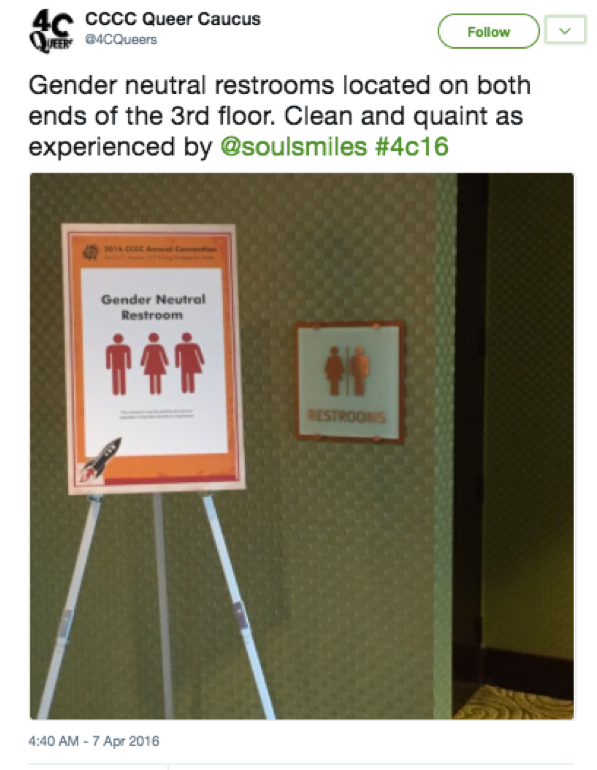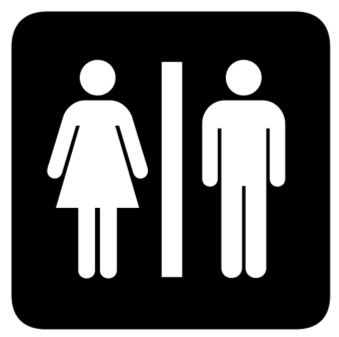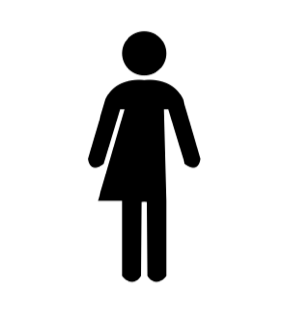The Indecorous Objects of Social Transformation
In the lead-up to the 2016 annual meeting of the Council of Writing Program Administrators in Raleigh, North Carolina, conference attendees used the group’s listserv to debate how best to respond to the state’s recent anti-LGBTQ legislation (HB2) that in part mandated which restrooms can be used by whom. Some conference registrants explained why they were foregoing the event, while others offered reasons for attending as an act of solidarity. Still others suggested material objects attendees might wear to signal their protest. One person proposed nametag ribbons with the hashtag “#WeAreNotHB2,” while another suggested “I’ll Go With You” buttons, which signal a willingness to volunteer as a bathroom buddy for transgender and other gender-nonconforming people. These latter suggestions obviously operate in part on the presumption that such objects of protest might help foment the social conditions necessary to protect LGBTQ rights. But how exactly does this activism work, at least from a rhetorical perspective? How can rhetoricians account for something as mundane as a button or a hashtag—or even a bathroom placard, as we will discuss below—as they get taken up in certain discourses that impact the social conditions that give meaning to such objects and the exigencies occasioning those discourses in the first place?
This article participates in the recent disciplinary turn toward object-oriented rhetorics to consider what we’re calling indecorous objects and how such objects affect social change. Indecorous objects can be material or abstract, but their defining quality is they signal a ripple in situations we might otherwise label familiar. They can be subtle or blatant, sober or amusing, outrageous or benign; regardless, indecorous objects are always linked to conventions and are thus context dependent. A lighthearted example is the series of fake “Animal Fact” signs that were recently posted in the Los Angeles Zoo.1 A more solemn example is the growing popularity of “Life Tape” worn by individuals to protest abortion.2 What matters is that indecorous objects disrupt commonplaces, and more importantly these disruptions are often unpredictable. While it might be easy to notice why an indecorous object disrupts a set of conventions, it’s more difficult to anticipate how these disruptions will affect the agents participating in those scenes.
In recent debates about LGBTQ rights, we can see how various arguments get manifested around particular objects that for some parties register as strange or off-putting: marriage certificates, wedding cake toppers, a Vanity Fair cover featuring Caitlyn Jenner. Such things exemplify how objects can activate rhetorical potential in contexts that may have previously been perceived to some observers as unsusceptible to change. To be fair, the history of LGBTQ activism is marked by the extensive use of various material objects as tools of resistance, especially in the form of “agitprops” like those developed in the 1980s by the activist art collective Gran Fury.3 In the present article, however, we are primarily focused on exploring the concept of indecorous objects as an extension of object-oriented rhetoric. In the next section, we outline how indecorous objects can be understood as vital agents in social transformation. We then look in detail at the example of transgender bathroom placards and how these objects influence perceptions of gender identity. We conclude by suggesting why accounting for indecorous objects can strengthen how we analyze and respond to social change.
Indecorous Objects as Vital Agents
We argue indecorous objects activate the potential of assemblages that have traditionally been defined by topoi or commonplaces that seemingly defy transformation. When we consider the relationship between indecorous objects and social change, we are thus reminded of what C.S. Peirce called the “irritation of doubt” (13), those moments when our prior experiences cannot account for our interactions with certain objects in the present. These irritations disrupt how we apperceive the world, so we adjust our beliefs about the objects in question to reestablish stasis—to reclaim a sense of normalcy, so to speak. But what happens when individuals resist such change? Peirce called this “the method of tenacity,” a kind of principled refusal to accept the possibility of novelty, i.e., a new or revised set of beliefs.4 But such tenacity is unsustainable in practice. “Unless we make ourselves hermits,” says Peirce, “we shall necessarily influence each other’s opinions” (16). While “we”—human agents—“shall necessarily influence” one another, what is the potential of nonhuman objects to trigger such irritations of doubt?
To consider how objects alter social conditions brings us into conversation with scholars like Nathaniel Rivers who use object-oriented rhetoric to understand publics as the product of human and nonhuman actors in antagonistic relations (“Tracing”). We suggest indecorous objects are thus identifiable in part by the antagonisms that can be registered when the relations between and among a set of objects becomes precarious. While it might seem reasonable to turn to Bruno Latour’s actor-network-theory (ANT) at this juncture, according to Latour assemblages have no “duree,” that is “everything happens only once, and at one place” (162). With ANT, there is quite literally nothing to change because no thing exists more than once—no event is ever replicated. To understand the debates underway concerning LGBTQ rights, for instance, ANT doesn’t offer a way to explain why there is so much social upheaval created by laws like HB2 or the placement of a transgender celebrity on the cover of a popular magazine.
We therefore join our voice with scholars interested in highlighting the limitations of understanding objects and the assemblages of which they are a part as only temporally-bound, emergent phenomena that can neither exist in the future nor be accounted for prior to emergence.5 After all, experience tells us that there are moments, objects, and assemblages that do have greater effect than others on material conditions. But this ability for change is not because objects are solely emergent, as ANT would have it, but because objects are, as Jane Bennett suggests, vibrant, that is, full of potential. Rivers nicely summarizes Bennett’s argument in this regard when he explains “our political and philosophical work needs to attend to the agency—the vibrancy—of objects…their thing-power” (“Tracing”).
Building on Bennett, we suggest indecorous objects alter social conditions because they activate the “thing-power” of other objects within an assemblage, which in turn results in the emergence of new relations that disrupt the perceived stasis of the assemblage. In other words, assemblages are stabilized when social conditions do not create discernable perturbations that require explicit reassessment of the objects at hand. It thus follows that change can be understood, at least in part, as the result of the discomfort that occurs when indecorous objects prompt us to account for a specific set of beliefs or expectations. To make such a claim is to take seriously both an ontology that dissuades the valuing of one kind of thing over another and the belief that some objects have more vitality than others to influence change in the assemblages of which they are part. A seemingly small change to an otherwise mundane object—say a restroom placard—can end up sending ripples of irritation that can force the incorporation of a contentious and complex national debate into what for many is a quite ordinary custom for labeling certain types of public spaces.
The “W” Doesn’t Stand for “Whatever”
Michael Scherer’s Time article “Battle of the Bathroom” opens with a scene from the 2016 Republican state convention in Texas where Dan Patrick, the state’s lieutenant governor, cracked jokes about transgender people during his keynote address. Scherer quotes one of Patrick’s lines that got the biggest laughs: “Now just so you are not confused, when you go to the restroom, the M does not stand for ‘make up your mind’ and the W does not stand for…‘whatever’” (32). These jokes, according to Scherer, are part of the conservative response to America’s changing “social fabric” in the wake of Supreme Court rulings on marriage equality and Obama’s efforts to mandate accommodations for transgender students in public schools (32). While it’s clear Patrick is eager to mock these developments, we believe it’s no coincidence he invokes the interpretation of restroom placards as a matter for ridicule. For many in Patrick’s audience, the transgender community probably seems strange, different, even deviant; but bathroom placards are commonplace. These are familiar objects and thus an easy surrogate through which Patrick can channel his anti-LGBTQ sentiments. Bathroom placards assume a metonymic significance, in other words one that allows people like Patrick to disparage the LGBTQ community without directly harassing them.
For those who are transgender, of course, these placards can invoke a range of significations that Patrick’s joke cheapens. As a case in point, we both recall the temporary sign indicating a gender-neutral restroom at the 2016 Conference on College Composition and Communication held in Houston’s downtown Hilton.

The sign, printed on corrugated display board with the 4C’s logo, was placed next to a restroom adjacent to the hotel’s ballrooms. We assume many readers of this article have seen versions of this temporary signage at academic conferences, which is to say signs indicating a gender-neutral restroom at academic conferences are becoming commonplace. The day after the conference ended, however, one of us took notice of the permanent placard for that same restroom. As you can see in the image above, it is a version of a familiar icon:

This is the standard icon for indicating a dual-sex restroom, of course, but at the time it was immediately striking the thought of this commonplace restroom placard in juxtaposition to the conference’s temporary signage. Specifically, how does the neutrality communicated by this standard dual-sex icon work against the neutrality communicated by signs that are explicitly marked as gender-neutral? The 4Cs went out of its way, after all, to carefully label that particular restroom. So why was the existing placard insufficient? To be sure, the dual-sex icon and the phrase “gender-neutral” work together in ways that are more complicated than they once were, especially for people who don’t identify as transgender. Even though the dual-sex icon indicates that one’s gender does not preclude them from using that space, to say that this icon indicates the space is gender-neutral isn’t necessarily the case. Just consider the difference between the standard dual-sex icon and the increasingly common transgender icon:

But also consider how there are some organizations that have taken a completely different approach by abandoning gender identification altogether on their restroom placards. According to a report in Inside Higher Ed, the restrooms at Cooper Union in New York City are labeled according to the contents of each space: “Restrooms With Urinals and Stalls,” “Restrooms With Only Stalls, “Restroom Single Occupancy” (Logue). Indeed, consider the design of a restroom placard at the University of California, San Diego, that doesn’t utilize anthropomorphic imagery:

While these are all examples of signs and icons that denote a gender-neutral space, the specific identifications they invite are no doubt different from one to the next. Indeed, we assume that many of North Carolina’s HB2 supporters wouldn’t think twice if they passed a public restroom with an icon on the placard like that in Figure 2, but that would probably not be the case if the icon was like that of Figure 3. While it’s easy to chalk up negative responses to the insensitivity and hostility directed at calls for gender-neutral restrooms, it’s important not to forget that social change both produces and is the product of perturbations that upset familiar assemblages. This is certainly not a defense of the cruelty we’ve seen from the likes of Dan Patrick and others who are satisfied to mock transgender people. But even the most welcoming and open-minded of us can be temporarily dismayed by objects that disrupt the familiar environs we inhabit. After all, a placard labeled “Restrooms With Only Stalls” might have the vitality to jolt some of us into the frames of mind necessary to reorganize those assemblages that categorize public restrooms according to gender identity, a connection we must recognize is a convention and thus subject to revision.
Conclusion
The growing necessity to account for both the explicit and implicit meanings of restroom placards and how these objects participate in the mapping of social norms are evidence of the ways indecorous objects get taken up and subsequently accounted for in rhetorical activity. But the ANT view of assemblages as singularly emergent with no history or future is insufficient for explaining the rhetorical force indecorous objects—whether restroom placards, hashtags, or anything else—bring to bear on discursive situations. We thus suggest one way to register social change is to identify the ways in which indecorous objects alter the conditions of seemingly stable topoi. Or to echo Bennett, we can try to identify how various objects might have “an energetic pulse slightly ‘off’ from that of the assemblage,” a potentiality that remains in reserve and which can resist, alter, and confound the assemblage itself (24).
Finally, this notion of indecorous objects doesn’t just add to the growing body of work concerned with object-oriented rhetorics; it also has the potential to inform rhetorical approaches to social change more generally. For example, scholars interested in the diachronic study of social movements might consider how the identification of indecorous objects might inform, say, James’s Darsey’s theory of “catalytic events,” which are “moments in the life of a movement that provide the appropriate conditions for discourse” (303). The important point is that indecorous objects help to mediate the potentiality for change in seemingly stabilized assemblages. We thus contend it is useful to think about indecorous objects in terms that highlight the ways they disrupt rhetorical ecologies by illuminating the myriad ways objects might assemble.
When we consider the range of transgender restroom placards, that there is no standard design evidences a kind of unstable assemblage that itself represents the social change currently underway concerning LGBTQ rights. For sure, there is still no consensus on these changes; moreover, LGBTQ and allied communities are still fighting for equal treatment, and that fight will no doubt continue for years and possibility decades to come. But we believe the varied attempts at expanding the discourses through which gender neutrality is both talked about and represented on objects like restroom placards, for example, is a sign that what for many Americans might at first felt strange and uncomfortable—protecting the rights of transgender people—will with enough saturation become familiar and even welcome.
Endnotes
- Designed to match the zoo’s existing signage, these posters pranked zoo visitors with messages like “Meerkats can control electronics with their minds” and “Penguins appear to have tuxedos because they are slowly evolving into 1920s business tycoons.” For more on this prank, see Gelman. return
- The pro-life activist group Bound4LIFE organizes what it calls “silent sieges” wherein supporters congregate in public areas while wearing “Life Tape,” which is simply a piece of tape with the word “LIFE” written on it and worn on one’s mouth. According to the organization, “We believe the Life Tape is a divine strategy from the Lord to both mobilize a massive movement of prayer and also to be a faithful witness to the nation” (“The Silent Siege”). return
- We are grateful to the manuscript reviewer who offered insight into this rich history. While there is much potential in thinking about agitprops as indecorous objects, such consideration is beyond the scope of this article. For more on the history of Gran Fury, see Emily Colucci’s interview with Gran Fury member Marlene McCarty (“Is Art Enough?”). return
- Here we follow Stephen Yarbrough’s definition of novelty as “beliefs that a discourse produces that could not have been implied from concepts governing the beliefs that previously the interlocutors held individually” (124). return
- Here we are thinking explicitly about Graham Harman who argues that ANT leads us to conceive of every change to an assemblage as totalizing; any minor recalibration or movement is evidence of a wholly new thing. As he writes, “If all relations were equally significant, then every entity would become a new thing in every trivial instance of its existence since our relations with objects are ever on the move” (Harmon 44). return
Works Cited
- Bennett, Jane. Vibrant Matter: A Political Ecology of Things. Duke UP, 2010.
- Darsey, James. “From ‘Gay is Good’ to the Scourge of AIDS: The Evolution of Gay Liberation Rhetoric, 1977-1990.” Readings on the Rhetoric of Social Protest, edited by Charles E. Morris III and Stephen H. Brown, Strata Publishing, 2001, pp. 301-325.
- Colucci, Emily. “Is Art Enough? Gran Fury in Perspective.” Hyperallergic, 21 Feb. 2012, hyperallergic.com/46881/gran-fury-read-my-lips-80-wse-nyu/. Accessed 17 July 2017.
- Gelman, Max. “Comedian Posts Hilarious Fake Facts Around Los Angeles Zoo.” New York Daily News, 5 July 2016, www.nydailynews.com/news/national/comedian-posts-hilarious-fake-facts-los-angeles-zoo-article-1.2699889. Accessed 13 July 2016.
- Harman, Graham. Immaterialism: Objects and Social Theory. Polity Press, 2016.
- Latour, Bruno. The Pasteurization of France. Translated by Alan Sheridan and John Law, Harvard UP, 1988.
- —–. Reassembling the Social: An Introduction to Actor-Network Theory. Oxford UP, 2005.
- Logue, Josh. “No More Men’s or Women’s Rooms.” Inside Higher Ed, www.insidehighered.com/news/2016/03/31/cooper-union-makes-all-bathrooms-gender-neutral. Accessed 29 Jan. 2017.
- Pierce, C.S. “The Fixation of Belief.” Pragmatism: A Reader, edited by Louis Menand, Vintage, 1997, pp. 7-25.
- Rivers, Nathaniel. “Tracing the Missing Masses: Vibrancy, Symmetry, and Public Rhetoric Pedagogy.” Enculturation: A Journal of Writing, Rhetoric, and Technology, vol. 17, 2014, enculturation.net/missingmasses.
- Scherer, Michael. “The Battle of the Bathroom.” Time, 30 May 2016, pp. 30-37.
- “The Silent Siege.” Bound4life.com, Bound4LIFE, www.bound4life.com/the-silent-siege. Accessed 24 Jan. 2017.
- Yarbrough, Stephen R. Inventive Intercourse: From Rhetorical Conflict to the Ethical Creation of Novel Truth. Southern Illinois UP, 2006.
Cover Image Credit: Wikimedia Commons
Keywords: materialism/materialist, object-oriented, change, LGBT, protest; activism/activist




 William Duffy and John Pell have been collaborators since they were both graduate students at the University of North Carolina at Greensboro. Their most recent coauthored scholarship includes "Freire in the Agora: Critical Pedagogy and Civil Discourse," published in Literacy in Composition Studies, and "Imagining Coauthorship as Phased Collaboration," published in the 2013 collection Working With Faculty Writers (Utah State UP). Will teaches in the Writing, Rhetoric, and Technical Communication program in the English department at the University of Memphis, and John serves as Director of Composition and is Assistant Dean of the College of Arts and Sciences at Whitworth University.
William Duffy and John Pell have been collaborators since they were both graduate students at the University of North Carolina at Greensboro. Their most recent coauthored scholarship includes "Freire in the Agora: Critical Pedagogy and Civil Discourse," published in Literacy in Composition Studies, and "Imagining Coauthorship as Phased Collaboration," published in the 2013 collection Working With Faculty Writers (Utah State UP). Will teaches in the Writing, Rhetoric, and Technical Communication program in the English department at the University of Memphis, and John serves as Director of Composition and is Assistant Dean of the College of Arts and Sciences at Whitworth University.